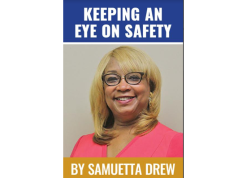By Glenn Ellis
From the time that Africans were enslaved on the west coast of Africa and packed onto ships for the horrific voyage across the Middle Passage, we have been intrinsically tied to the growth and development of the field of medicine in America.
This troubled history began with the substandard medical attention provided on the ships by doctors, whose charge was to keep as many enslaved beings alive as possible, in order to ensure the traders would make as much from the auctions that awaited them.
These doctors embraced their role, seeing it as an opportunity to enhance their reputations, as well as to improve their experience and practice dealing with a myriad of health issues within a captive patient base.
Once sold, and finding homes on plantations in this strange land, the inferior medical care continued. After all, there was an unlimited supply of human cargo headed, continuously, to America’s shores.
On the plantations in the South, doctors were few and far between, and their range of care was dependent upon their individual, professional training. Due to the shortage of doctors, the enslaved Africans were often left on their own to treat illnesses, handle medical emergencies, and to bring new life into this world. Many of these Africans continued to use traditional homemade remedies, folk beliefs, conjuring, and superstition to help meet their medical needs.
The shortage of doctors during this time was made worse by the fact that the Old South had only five medical colleges before 1845, and medical students spent only one to two years working with a preceptor and attended only a few lecture courses to complete their medical training.
In fact, due to the large numbers of enslaved Africans across the South, plantations provided a “training ground” for medical schools, students, and doctors. Many learned human anatomy through some of the most inhuman means, since people of African descent were thought by whites to be different in the physiology and medical needs. There was also an opportunity to conduct medical research, and to develop, and perfect, many medical procedures; some of which are still in common use in medicine today.
Professor Ran Hogarth calls this “Medicalizing Blackness” from her book of the same name. A few of the most notorious examples of this are:
Southern physician Samuel Cartwright M.D., who believed that the size of black people’s brains was “a ninth or tenth less than in other races of men,” while black people’s hearing, sight, and sense of smell were better. This “medicalization of blackness” wasn’t removed from the medical manual for Psychiatric diagnosis until the 1970’s.
Cartwright also is responsible for another instance of “Medicalizing Blackness.” He coined the term ‘’Drapetomania” (with Greek roots roughly translating to “runaway slave” and “crazy”) as a ” disease that causes slaves to run away.” Cartwright outlined a treatment for this “disease”; he reassured slaveowners that it was entirely curable by “whipping the devil” out of the slaves who suffered from it!
From these we know that Cartwright was among the first respected doctors throughout the country who saw being black and enslaved, and wanting to be free, was a psychological disorder.
Just as heinous as Cartwright’s assertion was the “work” of J. Marion Sims, M.D. who is considered the “Father of Gynecology”. Vesico-vaginal fistula (VVF) results in a tear from the bladder to the vagina, in pregnant women during a difficult labor. Sims is credited for perfecting the procedure to successfully treat VVF, to the relief and benefit of millions of (mostly white) women all over the world. Prior to Sims’ “contribution” to the field of gynecology, women in Europe and the United States who suffered with VVF became social outcasts rejected from society. Great advancement for medicine, right?
The problem is… Sims conducted the development and testing of this revolutionary procedure on enslaved African women. In order to conduct research, Sims also needed to learn and understand as much as possible about the little-known anatomy of a woman’s reproductive system. He also needed to carry out countless attempts to perfect the procedures and develop the right instruments. He did this all successfully, with one exception: Sims did these extensively invasive, surgical procedures, often without any anesthesia!
Probably, the brightest ray of hope began to shine for enslaved Africans, as it related to medical care, came around, and after, emancipation. This represented the period of the rise of black hospitals and medical schools, beginning with Freedman’s Hospital in 1862 in Washington, D.C.
However, this was not to signal a permanent change for the better for black health in the United States.
By 1920, there were over 200 black hospitals, staffed by black doctors and staff.
By some counts, this number reached almost 500 across the nation! But, between 1961 and 1988, 50 closed, and another couple of dozen merged. Today, there is only one black hospital…Howard University Hospital; and it is being managed by a hedge fund with a horrible record for running hospitals. One of their flagship hospitals, Hahnemann Hospital in Philadelphia closed last year as a result of poor management.
African Americans remain the least healthy ethnic group in the USA, a somber legacy of years of racial and social injustice. As we continue to celebrate our history and our heritage, let’s be mindful of the history of institutional racism in medicine.
Glenn Ellis, is Research Bioethics Fellow at Harvard Medical School and author of Which Doctor?, and Information is the Best Medicine. Ellis is an active media contributor on Health Equity and Medical Ethics. For more good health information visit: www.glennellis.com.





